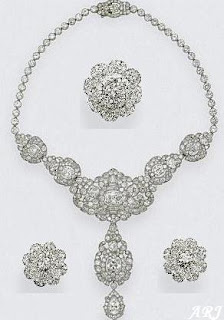Meanwhile, below is a summary of all the pieces that were covered:
Kent Diamond and Pearl Festoon Tiara
 |
| Princess Michael wearing her Aquamarine Set |
 |
| Princess Michael's Dress Ornament |
 |
| Princess Michael of Kent wearing the diamond and emerald pendant suspended from a pearl necklace |
 |
| Princess Michael's Cherries Brooch |
 |
| Princess Michael's Purple Flower Brooch |
 |
| Diamond and Emerald Shamrock Brooch |
 |
| Princess Michael of Kent wearing the Wild Pansy Brooch in a necklace |
 |
| Princess Marina (left) and Princess Alexandra (right) wearing the star pendants, also known as orange blossom hair ornaments |
 |
| The Kent Pearl and Diamond Festoon Tiara |
.JPG) |
| The Kent Aquamarine Tiara |
 |
| The City of London Fringe Tiara |
 |
| Victoria's Epaulette Earrings |
1.jpg) |
| The Kent Diamond and Pearl Tiara (current form) |
 |
| Princess Alexandra's Tiara (pearl setting) |
 |
| The Diamond "Snake" Bandeau in necklace form with matching earrings |
 |
| Duchess of Windsor's Ruby Set |
 |
| Empress Maria Feodorovna's Sapphire Choker |
 |
| Diamond Hat Ornament with Dresden Green Diamond |
 |
| The current button version of the Cambridge Sapphire Tiara |
 |
| The Timur Ruby Necklace: Timur Ruby is the centrepiece, flanked by two smaller spinels |
 |
| Princes Marina's Diamond Bow Brooch |
 |
| Princess Marina's Girandole Earrings |
 |
| Some of the jewels from the extensive Kent collection, current and former |
 |
| The Persian Turquoise Tiara |
 |
| Girandole Earrings |
 |
| The mystery diamond necklace worn by the Countess of Wessex for the wedding of Crown Princess Victoria |
 |
| Even Fringe Diamond Necklace |
 |
| King Fahd of Saudi Arabia Necklace |
 |
| King Khalid of Saudi Arabia Diamond Necklace |
 |
| King Faisal of Saudi Arabia Necklace |
 |
| Van Cleef & Arpels Dragonfly Brooches |
 |
| The Flame Tiara |
 |
| The Leuchtenberg Sapphire Parure |
 |
| The Duchess of Angouleme Tiara |
 |
| The County of Cornwall Ruby and Diamond Bracelet |
 |
| Russian Field Diadem |
.jpg) |
| The Russian Rose Brooch |
 |
| Princess Mathilde's Tudor Brooch |
 |
| The Burmese Ruby Tiara |
 |
| The current demi-parure parure - the necklace and the brooches |
 |
| Parts of the original parure: the necklace (with detachable centrepiece), the devant de corsage, and the earrings |
 |
| Elena of Montenegro's Tiara in its original form |
 |
| Elena wearing the tiara in its original form (left) and after modifications (right) |
 |
| Queen Margherita's Pearl Earrings |
 |
| Emerald, Diamond and Pearl Brooch |
 |
| The Iranian Sunburst Tiara |
 |
| The Savoy-Aosta Diamond Tiara |